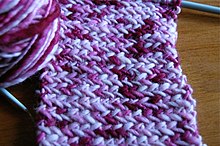


A herringbone stitch is a needlework stitch used in embroidery, knitting and crochet. It is so named as it resembles the bones extending from the spine of a herring fish. In knitting, it is a stitch that creates a fabric pattern closely resembling a herringbone pattern, or herringbone cloth.
A knitted herringbone stitch creates a firm fabric "similar to a woven in appearance and elasticity". A heavyweight fabric can be made with variations of the herringbone stitch, such as the herringbone twist stitch, which can be worked in either one or two colours; both versions are suitable for experienced knitters.
Cultural symbolism
The herringbone stitch is used as one of the symbolic motifs in the traditional knitted Aran jumper, or "fisherman's sweater"; specifically, the tradition as it exists in the Channel Islands of Guernsey, Jersey and Filey. The herringbone pattern represents the "fisherman's catch and thus for success in one's career".
See also
References
- Virginia Colton, ed. (1979). Reader's Digest Complete Guide to Needlework. Montreal: The Reader's Digest Association Canada. pp. 301. ISBN 0888500858.
- The Ultimate Source Book of Knitting and Crochet Stitches. Collins & Brown Limited; The Reader's Digest Association. 2003. p. 96. ISBN 0762104058.
- Domnick, Sabine (2007). Cables, Diamonds, Herringbone: Secrets of Knitting Traditional Fishermen's Sweaters. Down East Books. pp. 53, 71. ISBN 9780892726882.